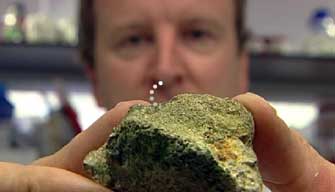
BBC.co.uk | 23 August 2010 | A small English fishing village has produced an out-of-this-world discovery.
Bacteria taken from cliffs at Beer on the South Coast have shown themselves to be hardy space travellers.
The bugs were put on the exterior of the space station to see how they would cope in the hostile conditions that exist above the Earth's atmosphere.
And when scientists inspected the microbes a year and a half later, they found many were still alive.
These survivors are now thriving in a laboratory at the Open University (OU) in Milton Keynes.

The experiment is part of a quest to find microbes that could be useful to future astronauts who venture beyond low-Earth orbit to explore the rest of the Solar System.
OU researcher Dr Karen Olsson-Francis told BBC News: "It has been proposed that bacteria could be used in life-support systems to recycle everything.
"There is also the concept that if we were to develop bases on the Moon or Mars, we could use bacteria for 'bio-mining' - using them to extract important minerals from rocks."

This type of research also plays into the popular theory that micro-organisms can somehow be transported between the planets in rocks - in meteorites - to seed life where it does not yet exist.
The Beer microbes were placed on the European Space Agency's (Esa) Technology Exposure Facility, a collection of experimental boxes at the end of the International Space Station's (ISS) Columbus Laboratory.
The bacteria were sent up still sitting on, and in, small chunks of cliff rock.
They would have been exposed to extreme ultraviolet light, cosmic rays, and dramatic shifts in temperature.
All the water in the limestone would also have boiled away into the vacuum of space.
Quite how they managed to come through their 553-day ordeal is now being investigated.
Bacterial spores have been known to endure several years in orbit but this is the longest any cells of cyanobacteria, or photosynthesising microbes, have been seen to survive in space.
The bugs have been classified simply as OU-20. However, they resemble closely a group of cyanobacteria known as Gloeocapsa.
They have a thick cell wall and this could be part of the reason they survived so long in space.
"Gloeocapsa forms a colony of multiple cells that probably protects cells in the centre to exposure from UV radiation and provides some desiccation resistance as well," explained Professor Charles Cockell, who works with Dr Olsson-Francis in the OU's Planetary and Space Sciences Research Institute.
"The ones we have are related to Antarctic species but they're also generally quite well-known in hot deserts. So, as well as the colony-forming habit, I suspect they've got quite good DNA-repair processes, too."
When the OU team despatched the Beer rock to the station, all it knew was that the cliff material contained communities of different bacteria. The scientists had no idea which, if any, would make it back to the ground alive.
Exposure on the platform therefore worked like a screen, identifying bugs likely to have special properties.
"We could send up the spores of known 'extremophiles' and we can be pretty sure they will survive because we know already they're really resistant," Dr Olsson-Francis told BBC News.
"Whereas in this case, we just used a community to select for these organisms. These are just everyday organisms that live on the coast in Beer in Devon and they can survive in space."
The Beer rock was launched to the ISS in 2008. More cliff material was also put on a much shorter space exposure experiment lasting 10 days the previous year. Called Biopan-6, it was lofted by the Russians.
OU-20 came through that challenge, too.
Biopan-6 was the experiment famously survived by a group of "water bears". These tiny invertebrates hold the record for the longest-lived animals in open space.
www.AstroDigi.com (Nino Guevara Ruwano)

No comments:
Post a Comment